The majority of enterprise content marketers don’t have a documented strategy, according to recent research. The CMI found that almost two thirds of professional content folk haven’t yet bothered to write down their strategy.
In some circles that’s akin to not having a strategy at all, but I don’t find it particularly surprising. Plenty of experienced, established teams seem to work without documentation in place, but it seems to me that content marketing has evolved to the point where it’s really easy to lose focus.
I’m currently going through the process of establishing a content strategy from scratch and thought I’d share what I’m doing, which I’ve summarised in the visualisation below. I guess each of these areas could be a chapter heading in a handy reference guide for the team.
All pretty top level, you understand, but I’ll explain a bit about each area below.
What do we mean by ‘document’?
There’s no standard template for this, so far as I know. In any event, what’s right for me might be wrong for you. But I would say that your ‘documentation’ should amount to more than a simple mission statement.
Big picture strategy slogans are one thing, but to actually make things happen, you need a lot of detail. Your team needs to know where to look – or who to look to – when they want something.
If you don’t have proper documentation in place, then they will look to you, and you will turn into a repetitive answer machine. Heavy bummer.
It might be that a lot of the supporting documentation already exists, in some shape or form. It’s just that it is unfinished, or out of date, or unstructured, and very possibly unshared. Why not put some time aside to get things together?
Assembling a collection of useful documents – alongside a goal-orientated series of targets – will help you to keep things on track. Your team will thank you for it, especially newcomers.
Let’s go through the four key areas to think about (Goals, Tactics, People, Processes), and the three others that are loosely filed under productivity (Assets, Tools and Tech).
In business, everything revolves around goals, unless you’re batshit crazy, so I’ll start there.
Goals
Content marketing teams exist to support all kinds of businesses goals. Some are more important than others. Goals can be strategic, tactical or based around task completion. Macro, micro, nano. Company, department, team member. Or mission, campaign, task.
Goals should be written down and ideally visible across teams, since you rarely work in a vacuum. Performance stats should be visible too, because transparency is a winning ticket.
Note that you always, always, always need a feedback loop, to measure what works and what doesn’t. Without that you cannot hope to function properly, nor maximise your chances of success. Nor, for that matter, demonstrate ROI (or the lack of it).

When it comes to goals, there are three main things to sort out…
Mission statement. This is your elevator pitch, and can probably be condensed into a sentence or so. You want to cram as much meaning and clarity in these few words as possible, to quickly answer questions such as “why are we investing in content marketing?”
Targets. You can use tools to set, assign and monitor goals, or just put something together in Google Docs and share it with whoever needs to see it.
Metrics. Once clearly defined goals and targets have been set you can take some measurements and track metrics as you move forwards. Set up your analytics reports and monitor performance as you progress.
Tactics
Once you know what your goals are, you can figure out how to go about achieving them. This is where tactics come into play.
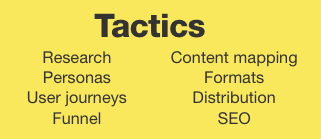
Research. Gut feel is a fine place to start, but tactics should be based around insight, rather than opinions. This calls for some research. Use whatever sources of data and information you can to build up a picture of the world according to your target audience.
Audience research. Figure out needs, where they like to hang out, what makes them tick, what they respond to, which competitors they talk about, who their friends are, who they respect… that kind of stuff.
Customer research. You need to know who your existing customers are before finding similar people. How do customers interact with your brand? What works?
Competitor research. It’s worth having a sniff around but there’s no need to obsess over competitor activity. Worry about your own game. Planning is a natural extension of worrying.
Personas and user journeys. Put together some personas, user stories, customer journeys, and make sure everybody is aware of the paths you want visitors to take.
Keyword research. This is rather more audience-centric than the foundational technical SEO basics, such as making your site fast. Search queries reflect consumer intent, and it is your job to create the kind of content that ranks well for target phrases.
Keyword research works best when it is truly strategic, with content mapped to specific business goals. Your content comes only after you have defined and prioritised your keyword wishlist. Or you’re doing it wrong.
Incidentally, I pretty much live by Dan Shure’s brilliant article on using the Keyword Planner in a creative way.
Funnel. How do your customers actually become customers? Understand the various journeys through the funnel. See what’s working, and think about how your content can play a role at each stage.
Content mapping. Great, you’ve mapped content throughout the funnel, but happens after somebody has become a customer? Increasing retention and customer advocacy are two of the best things you can do in business, and your content can go a long way in supporting these primary business goals. Take ownership, if necessary.
Formats. After you’ve done your homework, you can start to think about the actual content. Thoughts will turn to the type of content you might create, and the formats you can use. What is possible, given your team, your budget and your platforms?
Distribution. Hold up, cowboy. Don’t let the tail wag the dog. In this case the tail is content. And the dog, well, that’s distribution. Simply put, why are you making a video when you haven’t given a moment’s thought to YouTube? And what feeds YouTube? Ah yeah, reddit does.
These channels are potentially going to be the difference between a small win in local circles and a global viral. Why wouldn’t you want to optimise your distribution channel strategy?
How will people find your article? What’s your social strategy? Are you going to do any paid distribution? How are you going to nail down some excellent Google placements?
Figure out how to get the best out of your main channels, and you’ll get way more bang for your buck from each piece of content.
SEO. The devs probably need to be informed about your preferred search setup. Right?
Once you’ve got this together it becomes much easier to direct your efforts, and change tack if necessary.
The main success factor will be linked to the quality of content you create, and that’s something that you can also provide documented guidance on. Share internal and external knowledge, and make it easily accessible across teams.
People
You may know who everybody is and why they matter, but does the rest of your team? Think about the various people who stand to benefit from your success, and always remember the ones who took on some risk when you started out.

Stakeholders. Not just the boss, but heads of other teams that will be affected by your efforts. Who are they? What do they need to be effective in their jobs? How can content marketing support their primary goals? Also, what have you promised? Make the business case readily available to your team so they know what is expected of them. Share presentations and team goals.
Content team. Who’s in the dream team? Who is your star player? What is everybody focusing on? How does everybody communicate? That might be as straightforward as sharing a simple organogram and a bunch of invitations to Slack.
Other teams. Who do you ask for a new button to be designed? Where do the company mugshots live? Is there a shared Dropbox folder? What are the guidelines around using this stuff?
External talent. Maybe you hired a PR agency, who should be kept in the loop about major content campaigns on the horizon. Maybe you have three freelance writers who don’t work in our office. And that weird guy who makes kickass videos from a shady basement. How will these people work together and where do their contact details live for when somebody needs something?
Influencers. This is really important: know who you want to get friendly with. These community-annointed leaders of tribes can help you in a big way. What can you do to attract their attention? I tend to store influencers (including media lists) in a spreadsheet. Other people’s Twitter Lists can be a goldmine.
Processes
This is where the action happens. What are the things to do before and after publication? What do you need to do to get a piece of content over the line?
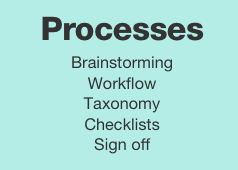
Brainstorming. Where do we store our ideas? How often do we get together? What tools do we use? What’s the formula for deciding what kind of content to create? Whiteboard sessions and mindmaps all play their part.
Workflow. How do we operate as a team, and as team members? How should we work with other teams? What is the process for submitting work?
What tools do we use? I’ve played around with Trello to Basecamp to Google Docs but have never settled on one goal-orientated platform (so I’m actually building one). People use tools differently and there is often some kind of protocol to follow, otherwise your world looks like to-do list spaghetti.
Taxonomy. What’s that you say about metadata? What is the common vocabulary for labels, tags and categorisation? Should I write Ecommerce or ecommerce or e-commerce or E-commerce or eCommerce? How does the tech work to support this kind of thing? If you have some rules in place, then you should police them.
Checklists. What needs to be done prior to publication? Or sign off? What boxes need to be ticked? Did you sense check everything?
Sign Off. Is there a sign off process? Who has final say? Do we really need to run everything past the PR agency? Who has publishing rights? Who is allowed to edit?
The Other Stuff
Assets, tech and tools pretty much sit between the three key areas and the goals. I see these things as being very much in the heart of the practical, and used, referenced and updated during the production phase.
Assets are things like brand guidelines, which should cover all of the dos and don’ts you need to know before publishing even the smallest status update. Authors must know your brand inside out before they represent it, right?
You’ll also need a house style guide, for content creators and editors. And ideally some pointers about things like when to publish, or how to write amazing headlines.
You’ll also be primed for success if you go to the trouble of creating (and maintaining) a schedule, be a that a shared calendar or loose, spreadsheet-based plan of action. Put some dates in the diary, get some targets in place, and watch out for the things on the verge of falling off the radar (or worse, the dreaded blockers).
Tech covers off the various platforms you will use (owned, earned, rented, paid, etc). That might mean a blog, a YouTube channel or a paid media channel. It’s probably all three.
Tech also points to your kit, and how the tech team can help improve efficiency and performance. For example, if you’re blogging, what are your CMS needs? How could the editing interface be improved? How should you report bugs? This might mean JIRA tickets, or something similar, so let your team know about how best to wave flags.
Platforms and technology can be optimised, which is where UX comes into play. Content lives at the heart of UX, but there are obviously factors outside of the content team’s control. Be sure to bang the drum if your site is slow, or if something is broken.
UX also covers persuasion, which is something of an artform among switched-on content marketers.
Then we have Tools, which primarily sit between people and process, and should help you to get things done. Pretty self-explanatory.
In summary
It’s worth pausing for thought if you are part of an existing team and you don’t have the right documentation in place. Where should I look for that style guide? Exactly what kind of person am I writing for, and why? Who should sign this off? These are questions that no right-minded team leader wants to answer on a daily basis.
Or maybe, like me, you’re starting something up, or you have a new client and a blank page. It’s tempting to jump straight into content creation, but in the long run it’s going to be way better to put a well-documented plan of attack in place, with goals and supporting assets all neatly lined up.
Either way, it’s worth regularly reviewing your strategy and updating your documentation, especially when adjusting course. To that end, I created The Content Strategy Canvas to help you get together a top level picture of what you have going on (click the pic for a big, hi-res version).
The canvas appears overly simplistic, but it is meant to be that way. It is a visual tool to help quickly communicate the key aspects of strategy on one page. No fluff required. The other documentation you might assemble having read this post will fill in the gaps.
And lo, you will become a cherished hero.
Anyway, that’s where I’m at. I’ll share a few specific content marketing templates in the future. I’d certainly love to hear any feedback and other approaches, so do leave a comment below or get in touch.
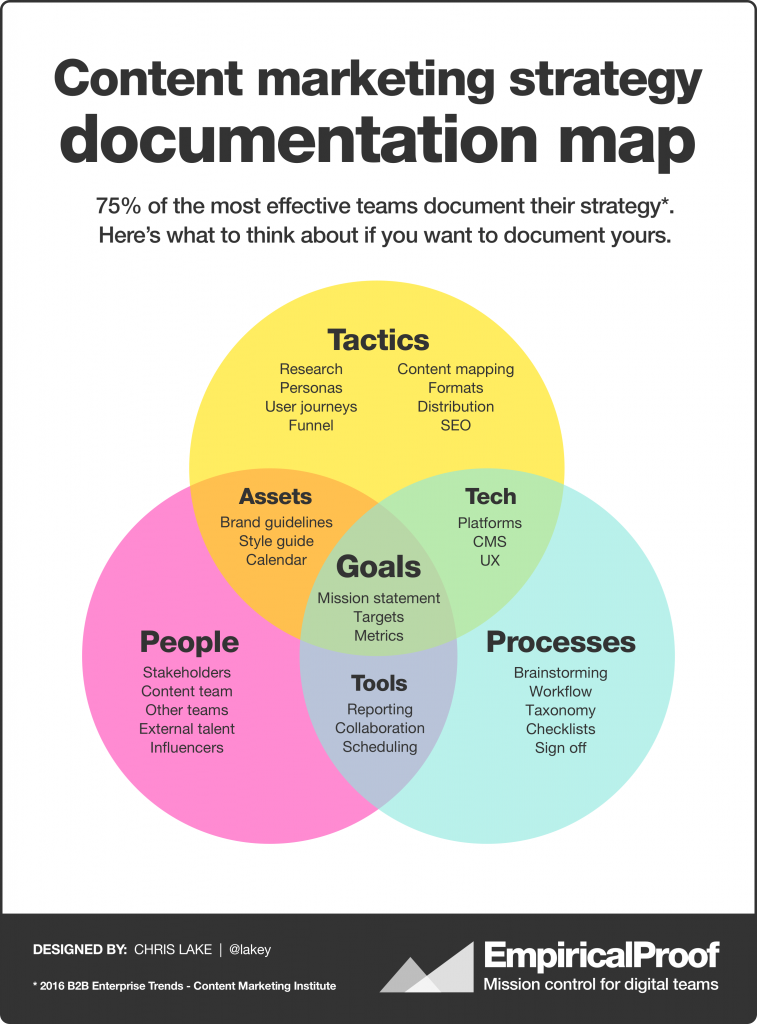
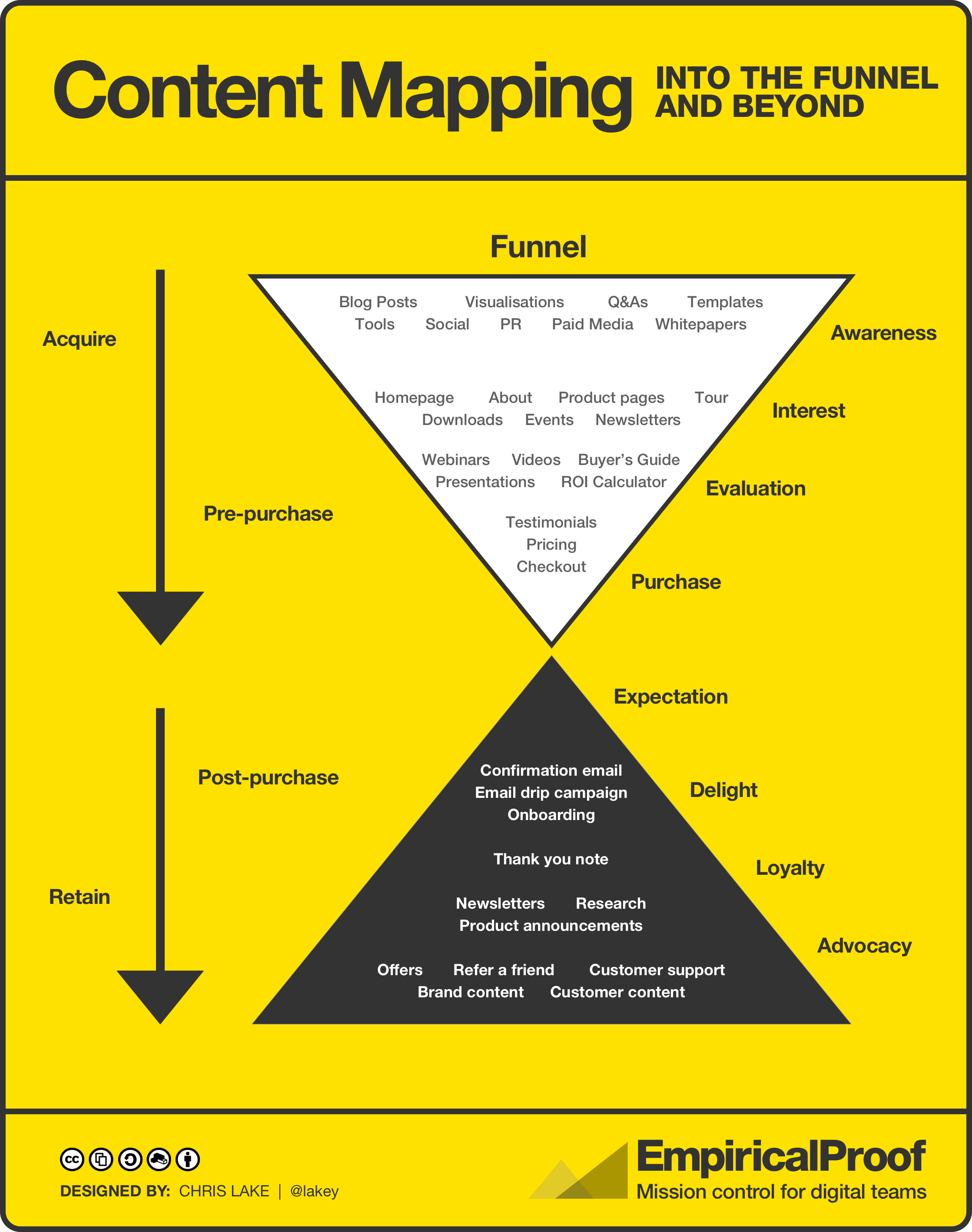
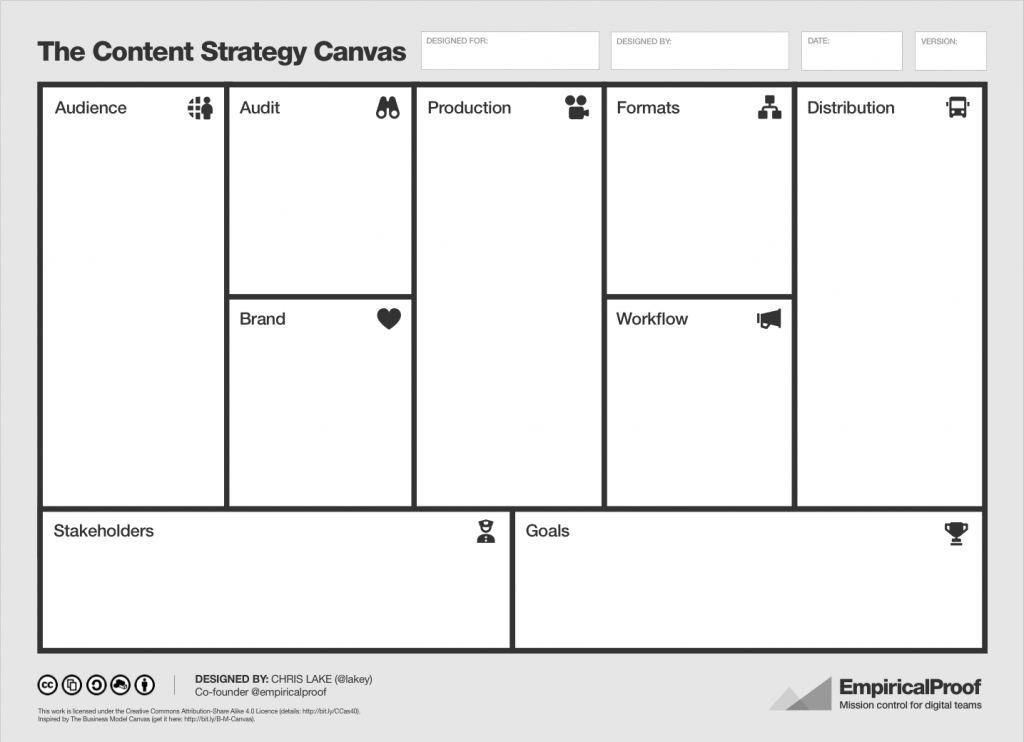
No comments:
Post a Comment